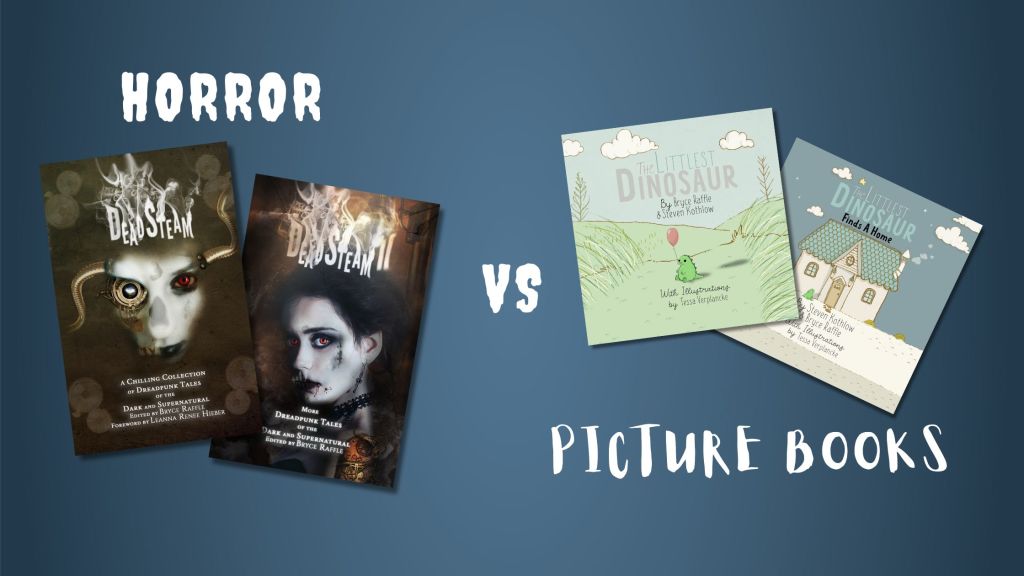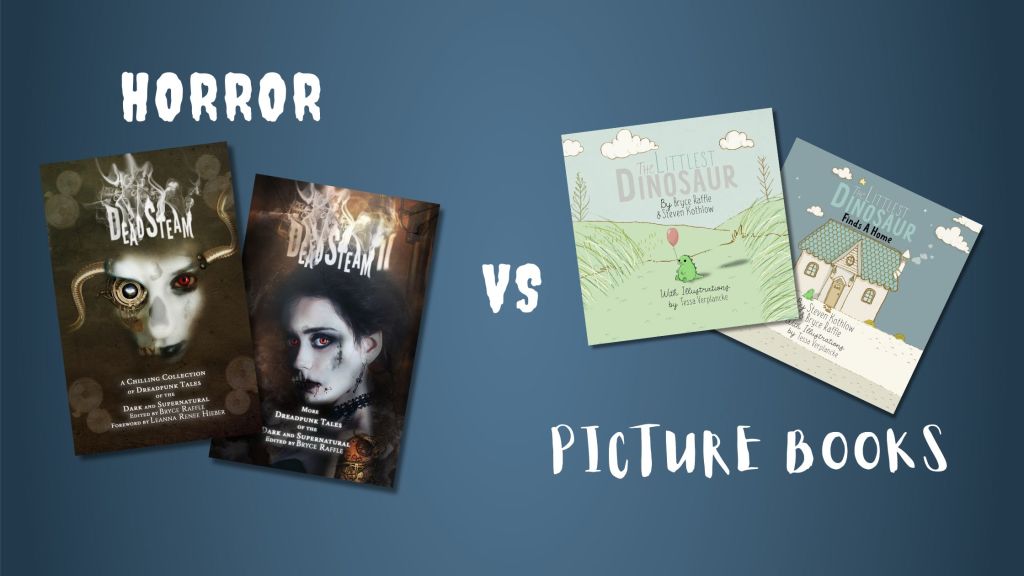When my old friend Jack Tyler invited me to join Threads That Bind, I hesitated. The truth is, it’s been a while since I’ve written horror. My writing career began with dark fantasy, dark steampunk, and gothic horror. I later edited the dreadpunk anthologies DeadSteam and DeadSteam II, contributing short stories to each. But since then, I’ve taken a bit of a sabbatical from dark literature. In fact, I’ve done a complete 180, spending the last four years developing an upbeat children’s picture book series called The Littlest Dinosaur with my co-writer, Steven Kothlow.

It’s been an amazing ride, and the response to our series has been overwhelmingly positive. Often, readers are surprised to learn that I’m also a horror writer. At other times, readers who know me for my horror are shocked to discover I write children’s books.
If I was going to get back into writing horror, I needed to give it some serious thought. Is there still space in my heart for horror? And if so, what is it about horror that still holds such a strong allure? I keep coming back to this one simple question: why horror, and why now?
Horror is a way to confront what frightens us.
For me, writing has always been more than just a hobby. It’s a calling. It’s also cathartic, a way of putting the ups and downs of life into words.
I’m amazed when I meet readers who assume that because I write horror, I must be depressed or some sort of blood-thirsty psycho. Once, a reader at a book signing declared that my book was “the devil” and refused to speak with me further. Another reader informed me that after reading my book, a bat entered their condo, and I must be to blame.
It’s interesting that the darkness in the writing is often projected onto the writer. But there is darkness in all of us, and there is light in all of us. Those of us who write horror are no more depressed than those who write romance, science fiction, or comedy. If anything, the opposite is true. Those who write horror are better equipped to handle the things that frighten us or cause us anxiety. We push ourselves through the darkness and come out more well-rounded because we can look our fears in the face.
I often write horror when things in my life are good, while I turned to writing picture books when I was at a low point. I needed that change of pace to pull me out of the darkness. Conversely, while things are good now, I find myself turning back to horror. I’m in a good place, which is the best time to confront the darker things in life.
After all, horror is about fear. What frightens us…what truly frightens us…must be dredged to the surface, like some undead creature, and brought to light to terrify our readers. What better way to confront what frightens us, as writers?
Horror offers a unique opportunity to confront fear in a controlled environment. This genre allows readers to experience terror and dread from the safety of their own home, creating a space where they can explore their deepest anxieties without real-world consequences. This confrontation with fear can be incredibly cathartic. By facing imagined horrors, individuals can process their real-life fears, gaining a sense of mastery over their emotions. This emotional workout can build resilience, helping readers to better cope with stress and anxiety in their everyday lives.
Moreover, horror provides a safe space to explore dangerous emotions like anger, grief, and despair. These emotions, often considered taboo or too intense for everyday conversation, find a natural home in horror narratives. Through the lens of horror, readers can delve into the darker aspects of the human experience, understanding and accepting these parts of themselves. This exploration can lead to greater emotional awareness and empathy, as readers recognize the universality of these feelings. Horror can thus act as a mirror, reflecting the inner turmoil that we all experience, but rarely express.
The adrenaline rush that accompanies a good scare is another key component of horror’s appeal. This physiological response to fear—heightened heart rate, rapid breathing, a surge of adrenaline—can be thrilling. For many, the excitement of this rush is a significant part of why they enjoy horror. It’s a form of escapism, where the intensity of the moment pulls them out of the mundane and into a heightened state of awareness. This blend of fear and excitement can be addictive, providing a rollercoaster of emotions that leaves the reader exhilarated. In this way, horror can be both a source of terror and a source of joy, offering a complex emotional experience that is both terrifying and thrilling.
Understanding the Roots of Fear
To write the most poignant horror, we must consider what people fear most. If you’re writing a story about a vampire crawling out of the grave, you must consider what it is about vampires that frightens us.
Vampire fiction emerged from the Victorian era, a time obsessed with the macabre. You’d think Victorians would be desensitized to the macabre, but many had a fear of being buried alive and went to great lengths to avoid such a fate. Perhaps this was because misdiagnosis was all too common. Considering this fear, stories about a creature rising from their coffin to prey on the living feel more poignant. Today, most people aren’t particularly worried about being buried alive. So how do we make vampires frightening? We might need to dig a little further.
What are people afraid of these days, compared to what they feared 100 years ago?
Horror as a genre has undergone significant transformation over the centuries, reflecting the evolving fears and anxieties of society. In its earliest forms, horror drew heavily on folklore and myth, with stories of ghosts, monsters, and witches. As society progressed, these tales evolved, incorporating contemporary fears and scientific advancements. The Gothic horror of the 18th and 19th centuries, like Mary Shelley’s Frankenstein and Bram Stoker’s Dracula, brought personal and societal anxieties to the forefront, blending supernatural elements with human emotion and moral questions.
Victorian horror was deeply rooted in the anxieties of the time. The rapid industrialization, the mysteries of the human mind, and the rigid social structures all played into the narratives of the period. In contrast, modern horror often focuses on more immediate and personal fears—psychological terror, technology gone awry, and the breakdown of social order. While Victorian horror thrived on the supernatural, modern horror frequently makes uses of graphic imagery and psychological complexity to unsettle its audience.
Historical events have always left an indelible mark on horror literature. The aftermath of wars, for instance, brought a surge in stories exploring the horrors of human nature and the consequences of violence. The Cold War era saw a rise in science fiction horror, reflecting fears of nuclear annihilation and alien invasion. More recently, the pandemic has influenced horror literature, bringing forth themes of isolation, disease, and societal collapse. These events shape the collective consciousness, and horror writers channel these anxieties into their stories, providing a way for society to process and understand their experiences. Through this lens, horror not only reflects our fears but also helps us to navigate and make sense of the world around us.
Why Horror, and Why Now?
So, why horror, and why now? Because horror forces us to confront our fears. It compels us to explore the darkest corners of our minds and the world around us. In a time of uncertainty and rapid change, horror can be a mirror reflecting our deepest anxieties and a way to process them.
I welcome this task, although it’s not without its challenges. If you’re reading this, I imagine you share my love of horror. Together, we can delve into the shadows, face our fears, and perhaps, find a little light along the way.

3 responses to “Horror vs Picture Books (or Good vs Evil)”
Ah, the “dark” author’s lament. Nobody ever assumes that a little grandma who writes stories about rabbits that wear clothes and bake carrot cakes in their little ovens believes that happens in her real-life worldview, but everyone assumes that horror writers are too dark and twisted for polite society. They sure like to buy our books, though, don’t they… Heh-heh!
LikeLiked by 2 people
Exactly this!
LikeLiked by 1 person
I was shocked to know that you can write children’s book lol Welcome back to the ‘dark’ side.
LikeLiked by 1 person